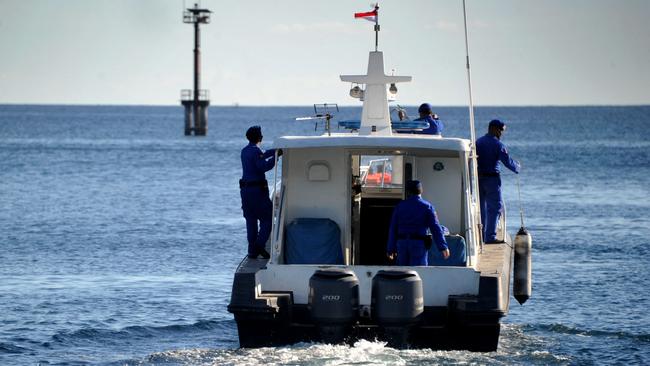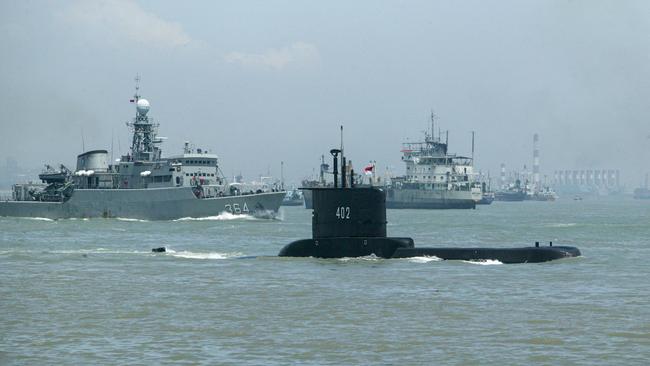Missing Indonesian submarine’s oxygen may have already run out
Indonesian general says there are ‘multiple reasons to think that all hope is lost’ for 53 people on board missing navy submarine.

Hopes are fading for the survival of 53 people on board a missing Indonesian navy submarine, with experts warning estimates that the ageing vessel had 72 hours of oxygen from the time it went missing early Wednesday were overly optimistic, and that it may already have run out of air.
Indonesian search teams are still awaiting the arrival of sonar equipment in waters north of Bali where KRI Ninggala first lost contact after diving during a torpedo drill around 3am (AEST 6am) Wednesday morning.
Both Australia’s HMAS Ballarat, which is equipped with sonar, and Indonesia’s own hydrographic survey vessel, KRI Rigel, are due to arrive later on Friday.
Indonesian military spokesman Achmad Riad said the arrival of the sonar ship KRI Rigel would speed up the search effort and help determine the exact location of the stricken 41-year-old submarine.
“By this afternoon or evening it will arrive and we can establish a more detailed plan,” Major General Riad said late Friday morning, local time.
“Right now we are prioritising the ships that have sonar detection capabilities. These ships will be able to follow up more deeply on the data we gathered yesterday.”
Indonesian navy chief Yudo Margono on Thursday said the oxygen would last until about 3am on Saturday, under the current situation in which the Nanggala is believed to be without power.
But retired Australian Navy Rear Admiral Peter Clarke told The Australian that if the submarine had sunk to a depth of 700 metres as is feared — well below the maximum 500 metre capacity of the KRI Nanggala — there was little chance that anyone will have survived.
“I think the amount that people might have been able to survive has been grossly overestimated,” said Rear Admiral (Ret) Clarke, who has previously commanded both nuclear-power and conventional submarines.
“If you look back to things like the Kursk (the Russian submarine that sunk in 2000) we were all thinking then that people might survive for five to ten days when actually we were talking hours, not days.
“The thing that would be most catastrophic in a situation like this is a submarine sinking well below operating depth, to a depth where a weak point in the hull fails, such as torpedo tubes or access hatches and then the water comes in very quickly. The more water comes in, the faster the submarine sinks eventually equalising the pressure inside, at which point it would be unlikely for people to survive.”
Siswanto Rusdi, director of Indonesia’s National Maritime Institute, said he too feared that without the Singaporean and Malaysian submarine rescue vessels _ which were not due to arrive until Saturday at the earliest _ there was little hope of extracting anyone alive.
“I’m almost 100 per cent certain these people are not alive anymore,” Mr Siswanto said.
“On paper, they have enough oxygen but in reality, this is a very old submarine whose maintenance is doubtful, so I suspect the military commander and the navy chief of staff is giving false hope.
“There are multiple reasons to think that all hope is lost. They are aware that the condition of the submarine makes it almost impossible for anyone to be alive in there. It is much deeper than the sub was designed for. I also suspect that the crew are not trained for these conditions.”
Mr Siswanto said it was also a “huge problem” that the navy did not have its own submarine rescue vessel
“This is a pressing need … and I don’t agree that it is not important because submarine disasters are rare. Singapore has, so does India and Malaysia.
The HMAS Balarat, which is equipped with sonar capabilities and an embarked MH-607 helicopter, is expected to reach the search area today, Australia’s defence ministry said in a statement.
The support ship Sirius is off the coast of Brunei and will arrive next Tuesday.
Both ships were diverted from separate regional deployments to join the search after Indonesia formally accepted Australia’s offer to assist.
“My thoughts are with the submariners of the KRI Nanggalam, their families and the Indonesian people,” Joint Taskforce 635 commander Mark Hammond said.
“As always we stand ready to assist our fellow mariners in the Indonesian Navy.”
The 44-year-old German-built KRI Nanggala-402 vessel is feared to have sunk to the bottom of a deep sea trench off Bali early on Wednesday with 53 people on board.
Indonesian navy spokesman Julius Widjojono said the Nangalla, a 1395 tonnes diesel-electric attack submarine, may have suffered an electrical failure and lost control as it submerged around 3.46am on Wednesday (5.46am AEST) during a torpedo drill 37km north of Bali.
While the vessel had 72 hours’ worth of oxygen on board — enough to sustain the 49 crew members, commander and three gunners until early on Saturday — there are fears it has sunk too deep to be rescued and is now at a depth beyond its capacity. If so it will be the first ever major submarine disaster in the Southeast Asian archipelago.
Modern submarines typically can dive safely to a maximum depth of 600m, while the dive capacity of the 1980-built submarine is far less than that.
Singapore, Malaysia and Australia are joining the search; Indonesia’s two closest Southeast Asian neighbours have already dispatched rescue vessels to help locate the sub, one of only five in the country’s submarine fleet — that lost contact after submerging during a torpedo drill off the north coast of Bali. Australia has said it will help “in any way we can”.
The Commander of the Indonesian National Armed Forces (TNI), Hadi Tjahjanto, said a search effort involving 21 ships, two submarines and five planes, police and the national search and rescue agency had been underway since Wednesday morning when the 209 Class submarine failed to surface 90 minutes after diving, and two crisis centres established in East Java and Bali.
“Assistance is also coming from Singapore, Malaysia and Australia. We are hoping all these search attempts will bring results and we hope to rescue all the Nanggala personnel,” he said, adding India, the US, Germany, France, Turkey and Russia had also offered assistance.
Air Chief Marshal Hadi said an initial aerial search had located an oil spill on the water where the submarine had first dived, indicating either that the submarine sustained damage to the fuel tank or had sent out an SOS signal.
A search ship had also detected “movement under the water at a speed of 2.5 knots” though contact had quickly been lost, leaving insufficient data to confirm whether it was the Nangalla.
Navy officials said a high-magnetic area had since been located at a depth of between 50m and 100m, which would be further explored with the expected arrival of a hydrographic survey ship in the area later on Thursday.
“We are using a sonar to search but it is different to searching for a black box. We think it is 600 to 700 metres beneath the surface. The submarine is capable of going 250 to 500 metres but beyond that it is quite fatal,” First Admiral Widjojono said.
“We need your prayers to find them. The faster the better.”

Foreign Minister Marise Payne said the federal government would “help in any way we can (though) we operate very different submarines from this one”.
“The Australian Defence Force and Australian Defence organisation will work with defence operations in Indonesia to determine what we may be able to do.”
Singapore sent its submarine rescue ship, MV Swift Rescue, on Wednesday, while the Malaysian navy dispatched the MV Mega Bakti rescue vessel on Thursday morning.
Indonesian Defence Minister Subianto Prabowo said the Nangalla had undergone two refits since its procurement in 1981 _ including a two-year refit in South Korea completed in 2012 _ and had only recently undergone a sea worthiness test. General Prabowo said the country was in the process of modernising its fleet, “but meanwhile we must use the existing fleet as well as possible”.
“The military always prioritises the needs of the people and is willing to face the risks with existing equipment … maintained as properly as possible, and used when necessary,” he said.
“Any equipment in the defence field carries an element of danger. It’s the way of life for a soldier. Operating a submarine is one of the toughest jobs in the military. To become a submariner you need certain psychological capabilities.
“We are now praying to rescue them safely. Hopefully they have enough oxygen for a few days. We are hoping for the best.”
The KRI Nanggala-402 is one of two old submarines made by Germany’s Howaldt Deutsche Werke and delivered to Indonesia in 1981 in an attempt to restrengthen its maritime power.
The country has since procured three Nagapasa-class diesel-¬electric attack submarines from South Korean builder Daewoo, the last of which, the KRI Alugoro (405), was launched in 2019.




To join the conversation, please log in. Don't have an account? Register
Join the conversation, you are commenting as Logout